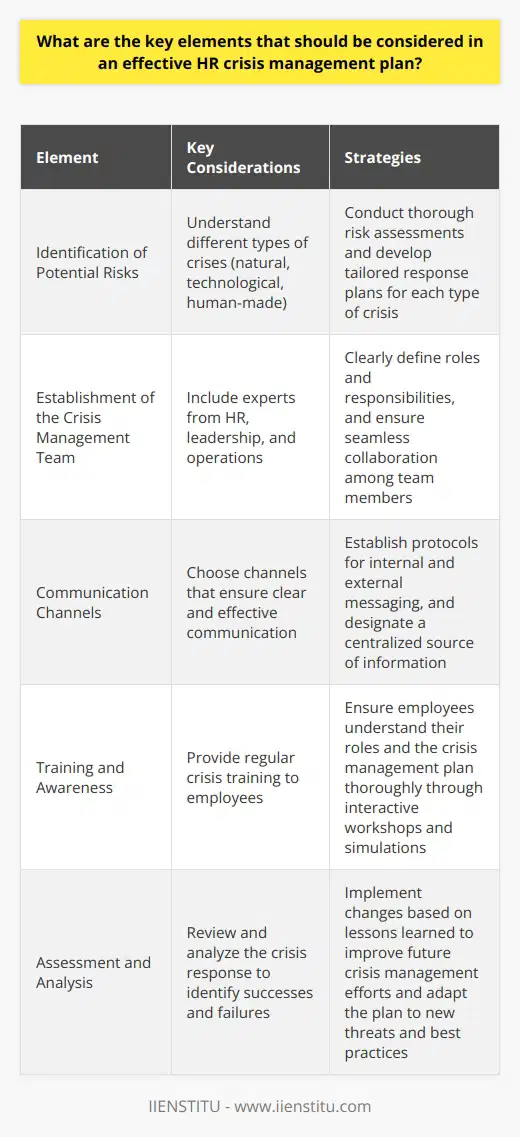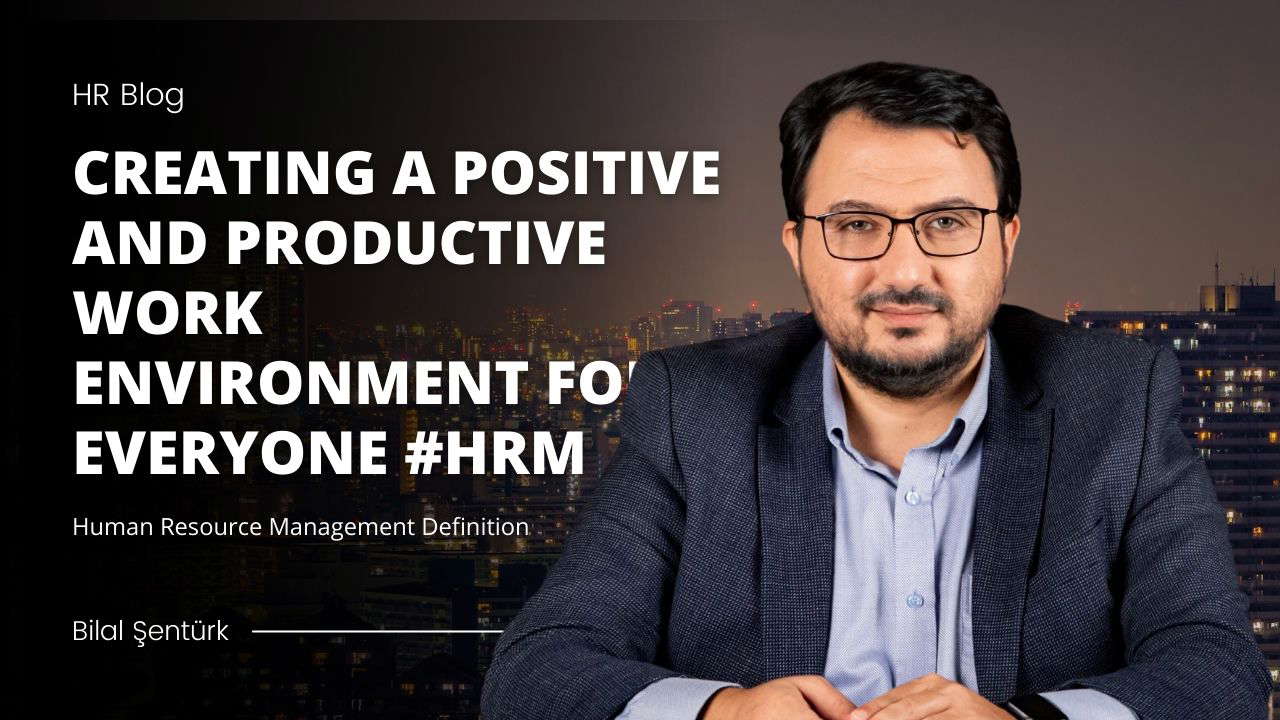
In the increasingly complex landscape of modern business, human resources departments are finding themselves at the forefront of crisis management. The multifaceted character of HR tasks ranges from recruitment to maintaining a healthy corporate culture. With the advent of unexpected events such as global pandemics or internal corporate strife, the adept handling of crises has become a pivotal function of HR professionals.
This article delves into the intricacies of HR crisis management, exploring how the field navigates challenges, mitigates risks, and evolves with emerging trends, while emphasizing the significance of human resources certification and the value of online courses with certificates in strengthening HR capabilities.
Introduction to HR Crisis Management
Definition and Importance of HR Crisis Management
HR crisis management involves the identification, planning, and response to events that threaten an organization's wellbeing or employee satisfaction. Effective HR crisis management is paramount as it helps to safeguard an organization's most valuable asset—its people. It is a strategic approach that ensures continuity of operations, maintains morale, and upholds the company's reputation during tumultuous times.
Managing crises from an HR perspective requires not only technical knowledge but also a profound understanding of organizational behavior and communication.
The Role of HR in Crisis Management
The role of HR in crisis management extends beyond administrative functions. It involves strategic planning, empathetic leadership, and clear communication. HR professionals are tasked with preparing for potential crises and leading the organization through these challenges swiftly and compassionately.
Their responsibilities cover a vast spectrum that includes supporting affected employees, aligning crisis response with legal requirements, and maintaining a harmonious work environment.
Types of HR Crises
Recruitment Crisis
A recruitment crisis can arise when a company struggles to fill critical positions. This is typically due to a scarcity of skilled candidates, a poor employer brand, or external economic factors. The impact of a recruitment crisis is severe, as it can hinder a company’s ability to achieve objectives, driving them into an operational impasse.
Retention Crisis
Employee turnover, particularly of highly skilled workers, can precipitate a retention crisis. Root causes may be inadequate compensation, a toxic workplace culture, or lack of career development opportunities. The associated costs are high since they entail not only the immediate financial burden of replacing workers but also the loss of institutional knowledge and productivity.
Leadership Crisis
Leaders are the keel and rudder of an organization, offering direction and stability. A leadership crisis can occur when there's a sudden departure of key leaders or when ineffective leadership fails to guide and motivate. This can create a vacuum that disrupts the organization's trajectory, calling for swift and strategic remedies to restore confidence and continuity.
Cultural Crisis
A cultural crisis may emerge from disconnects between an organization's stated values and actual practices. It reveals itself through widespread disengagement, inter-departmental conflicts, and a stifled innovation climate. Addressing a cultural crisis often requires deep-seated changes that begin with a critical assessment of core values and behaviors.
Crisis Due to Harassment or Discrimination Allegations
A crisis of harassment or discrimination can inflict severe damage to a company's reputation and employee morale. It is vital for HR departments to foster an environment of respect and zero tolerance for such behaviors. The swift and just handling of these allegations is critical in mitigating its impact and reinforcing an organization's ethical stance.
Example of Each Type of Crisis and Its Impact
Every crisis is unique, but they typically share a common result—an upheaval in normal operations and a potential decline in trust within the organization. For instance, a well-known tech company faced a cultural crisis when allegations of a toxic workplace culture surfaced, leading to high-profile resignations and a tarnished brand image. The crisis spotlighted the insufficient mechanisms within the HR framework to address systemic issues.
Strategic Planning for HR Crisis Management
Importance of Preparation
Crisis preparedness is not just about having a plan; it’s about anticipating the unexpected and having a blueprint for action. Preparation equips HR with the tools necessary to respond effectively, minimizing harm and allowing for a quicker return to stability. Organizations that plan are shown to fare significantly better than those caught off guard.
Steps in Developing a Crisis Plan
Identifying Potential Crises
The initial step in crisis planning is to identify all conceivable scenarios that may affect the organization. Regular risk assessments conducted by the HR team can highlight areas of potential vulnerability and provide the foundation for a proactive plan.
Establishing the Crisis Management Team
An effective crisis response necessitates a dedicated team with clearly defined roles and responsibilities. This team should be a cross-functional group capable of rapid response and decision-making, often encompassing top HR professionals and key stakeholders from different departments.
Developing Objectives and Strategies
With potential crises identified and a team in place, HR must outline concrete objectives and develop strategies aimed at addressing each identified risk. This phase entails crafting detailed action plans for communication, employee assistance, and operational continuity, along with training initiatives.
Reinforcing the Importance of Transparent and Effective Communication During Crises
Open and frequent communication is integral to crisis management. Transparency helps in alleviating uncertainty and fostering an atmosphere of trust. HR should establish communication protocols and designate spokespersons who can provide consistent messages across all channels.
Example of How Preparation Can Prevent Crises or Lessen Their Impact
Companies that invest in human resources certification and cultivate expertise through comprehensive online courses with certificates are often better prepared for crises. For instance, an organization with a high degree of preparation was able to mitigate a recruitment crisis by tapping into a pre-established talent pipeline, thus ensuring the timely appointment of essential personnel and minimal disruption to operations.
Implementing the Crisis Management Plan
Activating the Crisis Management Team
Upon the indication of a crisis, the crisis management team must be swiftly activated. This team will coordinate the implementation of the crisis plan, making dynamic decisions as the situation evolves and ensuring all actions align with the organization's values and legal obligations.
Implementing the Strategies Developed in the Crisis Plan
The strategic response to the crisis involves executing the predefined action plans. This may include deploying resources, connecting with external support services, or initiating emergency protocols. The key here is action—the theoretical plan must become a practical solution.
Showing Empathy and Support for Employees During the Crisis
In the heat of crisis management, HR professionals must not lose sight of the human element. Emphasizing empathy, they should ensure that support structures for employees are in place and accessible, addressing their concerns with care and understanding.
Providing Transparent and Regular Communication About the Crisis
The frequency, clarity, and honesty of communication from HR departments during a crisis cannot be overstated. It must convey the relevant facts, what is being done in response, and how it affects the employees, thereby reducing speculation and anxiety.
Example of Effective Implementation of a Crisis Plan
An illustrative example of successful crisis management is a retail company that, facing a retention crisis, implemented a comprehensive plan with improved career paths, competitive remuneration packages, and a robust employee engagement program. These initiatives were communicated through town halls and personal meetings, ensuring widespread understanding and buy-in.
Post-Crisis Actions and Lessons Learned
Importance of a Thorough Evaluation After the Crisis
A post-mortem analysis is indispensable once a crisis wanes. It provides the organization with the opportunity to understand what worked, what didn't, and why. This step is crucial for refining the crisis management plan and fortifying the organization against future threats.
Learning and Improving the Crisis Plan Based on the Experience
The lessons gleaned from the evaluation phase must inform amendments to the crisis management plan. HR should address any shortcomings and reinforce successful strategies, perpetuating a culture of continuous improvement and resilience.
Rebuilding Trust With Employees After a Crisis
After a crisis, HR has a pivotal role in restoring and potentially enhancing trust with employees. Trust is repaired through demonstrated commitment to changes and sustained efforts to improve the workplace environment, aided by the respective human resources certification and credibility it brings.
Example of Effective Post-Crisis Actions and the Lessons Learned
The lessons learned from the tech company's cultural crisis mentioned earlier included a dedication to transparent salary structures and the establishment of internal channels for voicing concerns without fear of reprisal. Following the crisis, this company emerged with a strengthened HR framework, leading to improvements in employee satisfaction and a gradual rebuilding of its brand image.
Conclusion: The Future of HR Crisis Management
The Ongoing Need for Effective Crisis Management
The dynamism of the modern business environment necessitates an unrelenting focus on crisis management. HR professionals must remain vigilant, adaptive, and prepared for the panoply of challenges that lie ahead.
Current Trends and Future Developments in HR Crisis Management
Emerging trends such as the increasing prevalence of remote work, the rise of artificial intelligence in employee monitoring, and the growing awareness of mental health issues indicate that the scope of HR crisis management will likely continue to evolve. Online courses with certificates provide an accessible avenue for HR professionals to stay abreast of these crucial developments.
Final Thoughts on the Subject
The efficacy of HR crisis management is not solely evident in how a crisis is tackled, but also in how it positions an organization for post-crisis growth and renewed strength. By investing in human resources certification and a commitment to continuous learning, HR professionals can pivot from reactive to proactive, ensuring that they are not left behind by the inevitable march of change.
Frequently Asked Questions
What are the key elements that should be considered in an effective HR crisis management plan?
Introduction
Crisis management is crucial for HR. It ensures continuity and stability. HR must anticipate and plan. This plan involves several elements. Each requires careful consideration and strategy.
Pre-Crisis Planning
Identification of Potential Risks
First, understand potential crises. They can be natural, technological, or human-made. Each type demands different responses.
Establishment of the Crisis Management Team
A dedicated team is essential. It must include HR, leadership, and operations experts.
Communication Channels
Clear, effective communication is critical. Choose your channels wisely. Set protocols for internal and external messaging.
Training and Awareness
Employees need regular crisis training. They must know their roles. They should understand the plan thoroughly.
During Crisis Response
Activation of the Emergency Plan
Quickly activate your crisis plan. Time is an essential factor. Be decisive and clear.
Centralized Communication
Information must flow from a central source. This avoids misinformation and panic.
Protection of Employees
Employee safety is the top priority. Ensure all staff secure themselves first.
Documentation and Compliance
Document every action and decision. Compliance with laws and regulations is non-negotiable.
Post Crisis Management
Assessment and Analysis
Review and analyze the crisis response. Learn from successes and failures. Implement changes to improve future responses.
Support and Recovery
Provide emotional and professional support. Help employees recover from the crisis.
Communication with Stakeholders
Keep all stakeholders informed. Transparency helps to maintain trust.
Update and Adapt the Plan
Use insights gained to refine the plan. Adapt it to new threats and best practices.
Conclusion
A robust HR crisis management plan is comprehensive. It focuses on prevention, action, and recovery. Through preparation and adaptability, HR can protect both people and the organization.

How does HR crisis management contribute to overall organizational resilience during times of uncertainty or change?
HR Crisis Management: A Pillar of Organizational Resilience
In times of uncertainty or change, resilience stands as a key characteristic of successful organizations. HR crisis management is not only a response mechanism. It acts as a foundational contributor to resilience. It ensures strategic alignment with organizational goals. This alignment fosters a proactive, rather than reactive, stance.
The Role in Preparation and Prevention
HR crisis management begins with risk assessment. HR identifies potential threats. It assesses the stability of the workforce. It examines the impact of various crisis scenarios. This preventive approach lessens the likelihood of crises. It ensures preparedness.
Critical Communication
Clear communication is imperative. HR promotes timely and accurate information sharing. This reduces speculation. It avoids misinformation. It keeps the workforce confident and informed during crises.
Maintaining Continuity
HR designs continuity plans. These plans prioritize critical functions. They ensure business processes run despite disruptions. This ensures services and products remain available. It sustains revenue streams. It maintains customer trust.
Employee Support and Well-being
Supporting employees is central to HR's role. HR provides resources for mental and physical health. It addresses emotional well-being. This encompasses counseling to financial assistance. Such support minimizes stress. It promotes focus. It fosters a work environment conducive to overcoming adversity.
Talent Management and Flexibility
Flexible talent management becomes crucial. HR adjusts staffing levels responsibly. It differentiates between essential and non-essential roles. It cross-trains employees. HR creates a versatile workforce. This agility enables the organization to shift gears swiftly.
Regaining Stability
After a crisis, HR leads recovery efforts. It assesses the impact. It makes necessary adjustments. It learns from the experience. This continuous improvement cycle solidifies resilience. It prepares the organization for future challenges.
Strategic Leadership Involvement
HR guides leaders. It ensures their decisions reflect the concern for the workforce. This reinforces trust. It strengthens the collective resolve. It unites the organization.
Change Management
Changes often accompany crises. HR provides the frameworks for managing such changes. It aligns change initiatives with long-term strategic goals. It fosters adaptability. It ensures the workforce embraces new directions.
Legal and Ethical Considerations
HR navigates the complex web of legal obligations. It ensures the organization's actions remain ethical. This reduces liability. It upholds the company's reputation. It instills public and shareholder confidence.
In conclusion, HR crisis management equips organizations with the tools to survive and thrive. It enhances their resilience. It takes them through uncertain times. It ensures they emerge stronger and more unified.

What strategies can HR professionals employ to mitigate risks associated with the shifting landscape of remote work and increased digital dependence?
Understanding the Shift
Today's workplace is evolving rapidly. Remote work and digital reliance are not trends. They are new norms. HR professionals recognize this transformation. They are pivotal in adapting organizations to these changes.
Strategic Risk Mitigation
Mitigation begins with a strategic approach. Identifying risks associated with remote work is crucial. This is a starting point. It sets the groundwork for implementing safeguards.
Clear Policies
HR must develop clear remote work policies. These guide employee behavior. They set expectations for performance and professionalism. Such policies cover work hours, data security, and communication protocols.
Technology Support
HR should ensure adequate technology support. Employees need reliable tools to perform well. A strong IT infrastructure is essential. It must support remote work effectively.
Training Programs
Training employees is necessary for digital tools proficiency. HR should coordinate these training efforts. They should cover data protection and cyber security as well.
Cyber Security Measures
Cyber security is non-negotiable. HR should work with IT to enforce robust security measures. This includes secure connections and multi-factor authentication.
Regular Check-Ins
Communication is key. HR professionals should establish regular check-ins. These maintain engagement and support for remote employees.
Employee Wellbeing
Employee wellbeing is a top priority. HR must address challenges like isolation and burnout. Tools like digital wellbeing platforms can help.
Inclusive Culture
Cultivating an inclusive culture is vital. HR should ensure remote workers feel connected. They should promote an organizational culture that supports collaboration.
Data Management
HR professionals should handle data with care. They must understand legal implications of digital data storage. Protections for employee information are a must.
Legal Compliance
Staying compliant with labor laws is important. HR must navigate the complexities of remote work legislation. This includes issues like overtime and jurisdictional challenges.
Performance Management
Redefining performance management for remote work is essential. HR should focus on outcomes, not just activities. This shift supports productivity and acknowledges remote work dynamics.
Contingency Planning
HR should develop contingency plans. These are needed for potential tech outages or cyber-attacks. They ensure continuity and limit downtime.
Flexible Solutions
HR must remain flexible. The digital landscape is ever-changing. Adapting to new technologies and work patterns is crucial.
Forward-Thinking HR Leadership
Ultimately, HR leaders must think ahead. They must anticipate future shifts in the work environment. This proactive stance enables organizations to thrive in a digital, remote world.



